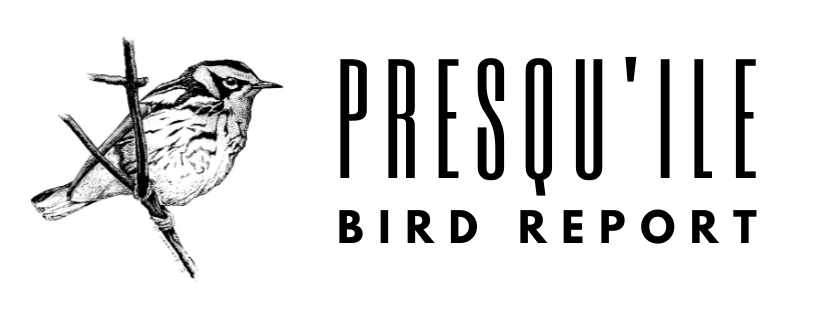
Presqu'ile Provincial Park, like much of southern Ontario, has been experiencing relentless hot weather, but that has not deterred a number of birders from seeking out birds that would otherwise be unwatched. What they are finding includes several species normally seen either as single birds or in pairs that are now showing up in aggregations that, in some cases, are in double digits, which are assumed to be family groups including recently fledged young birds. Readers who are accustomed to listings of birds in a particular (taxonomic) order will have to become familiar with a recently changed sequence that is incorporated below.
Three species of swans were off Sebastopol Island this morning: the ubiquitous MUTE SWANS plus single individuals of TRUMPETER SWAN and TUNDRA SWAN (rare in summer). Among the less common ducks seen this week in the Owen Point/Gull Island area were AMERICAN BLACK DUCK, NORTHERN SHOVELER, two GREEN-WINGED TEAL, and two GREATER SCAUP, as well as a WHITE-WINGED SCOTER near the lighthouse. A banded ROCK PIGEON was in a campground on Sunday. This morning a BLACK-BILLED CUCKOO was calling at the beach 2 parking lot. A COMMON GALLINULE with nine very young chicks was in the woodpile marssh on Sunday.
The algae mats favoured by shorebirds have begun to develop at and north of Owen Point, and a few shorebirds have returned from the north, including an early BLACK-BELLIED PLOVER on Tuesday and Wednesday and an early SEMIPALMATED PLOVER on Sunday. There is likely still time to see the PIPING PLOVERS that nested on the beach last month before the three young ones exercise their newly developing flight skills to leave for greener pastures. An AMERICAN WOODCOCK flushed from the Owen Point trail. A LESSER YELLOWLEGS was on the beach on Sunday. Single BONAPARTE'S GULLS have been at Owen Point and at the lighthouse.
A few COMMON LOONS have been flying about, as was a juvenile AMERICAN BITTERN with stubby wings. As many as eleven GREAT EGRETS were visible today on High Bluff Island. A GREEN HERON flew across the outer part of Presqu'ile Bay towards the lighthouse. Among the egrets there was also a BLACK-CROWNED NIGHT-HERON. An immature BALD EAGLE was at Owen Point today, and two GREAT HORNED OWLS were seen from the marsh.
Two observers saw a pair of PILEATED WOODPECKERS flying over the calf pasture yesterday and another observer saw three today, including an adult feeding a fully grown young one near the beach 2 parking area. Three MERLINS were at the calf pasture on Sunday, and one today. It is usually difficult or impossible to differentiate between newly arrived fall migrants and birds that have summered nearby, but the OLIVE-SIDED FLYCATCHER that showed up on July 31 seven years ago was clearly one of the former and remains a reminder that flycatchers and other land birds could be on the move with the next cool front. On the other hand, a group of five GREAT CRESTED FLYCATCHERS seen today was undoubtedly a locally raised family group. The forty BANK SWALLOWS out over the lake, the four BROWN CREEPERS seen together, and the four FIELD SPARROWS including a fledged juvenile were also likely in that category.
To reach Presqu'ile Provincial Park, follow the signs from Brighton.
Locations within the Park are shown on a map at the back of a tabloid
that is available at the Park gate. Access to the offshore islands is restricted
at this time of year to prevent disturbance to the colonial nesting birds there.
There is also a restricted area at beach 2, where the public is being directed away from the Piping Plover fledglings.
Birders are encouraged to record their observations on the bird sightings
board provided near the campground office by The Friends of Presqu'ile Park
and to fill out a rare bird report for species not listed there.
Questions and comments about bird sightings at Presqu'ile may be
directed to: FHELLEINER@TRENTU.CA.


